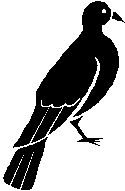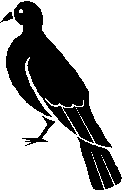|
| |
|
Human Uses
Humans used the passenger pigeon in many different ways. It was an
important food source; they served it fresh, smoked, salted, pickled and
as jerk. They used its fat in the kitchen and its feathers for
bedding. Parts of the passenger pigeon were also used in some medicines
back when almost everything was used for some medicinal purposes. It
was believed that their blood helped disorders in the eyes, coats of the
stomach in powder form cured bloody fluxes, and that their dung mixed
with Anodyne force helped to reduce headaches, pain in the side and
stomach. Professional passenger pigeon trappers and farmers also
harvested these birds for money.
|
Citation:
Schorger, A. W. (1955). The passenger pigeon: Its
natural history and extinction. Madison: The University of Wisconsin
Press.
A diagram of a typical trap used to capture
the pigeons
|
Capture
There were many different methods used for capturing passenger pigeons.
Some of these methods included the use of shotguns, long sticks for
hitting birds out of their nests, collecting birds that had fallen
naturally, felling entire trees, suffocation by the burning of sulfur or
grass and shrubs underneath the
nests, leaving alcohol-soaked grain and
then gathering the intoxicated birds, netting and trapping. Trapping
was found to be the most effective harvesting method. To trap the
birds, grain or salt was used for bait. Live pigeons that had their
eyes sewn shut were tethered to a perch called a stool around the bait
to help attract other birds (where the term “stool pigeon” came from).
Then a net that was attached to a frame was released and trapped the birds.
With this method up to 30 dozen pigeons could be trapped at one time.
The building of railroads boosted the pigeon trade immensely because
birds could be killed in greater numbers and then shipped across the
country.
|
Next
Page
|



